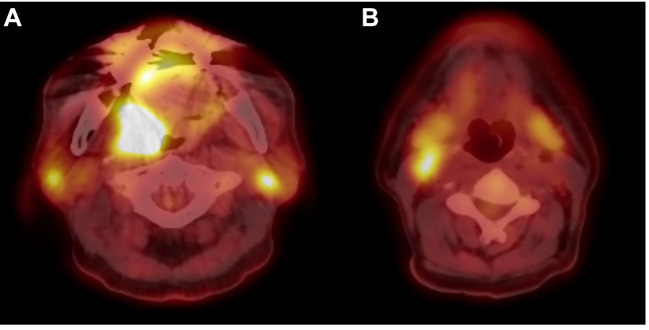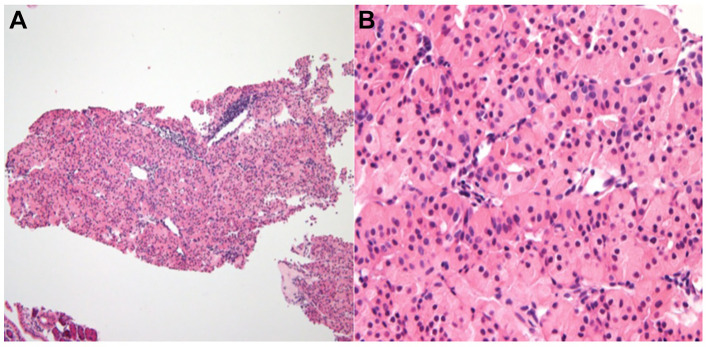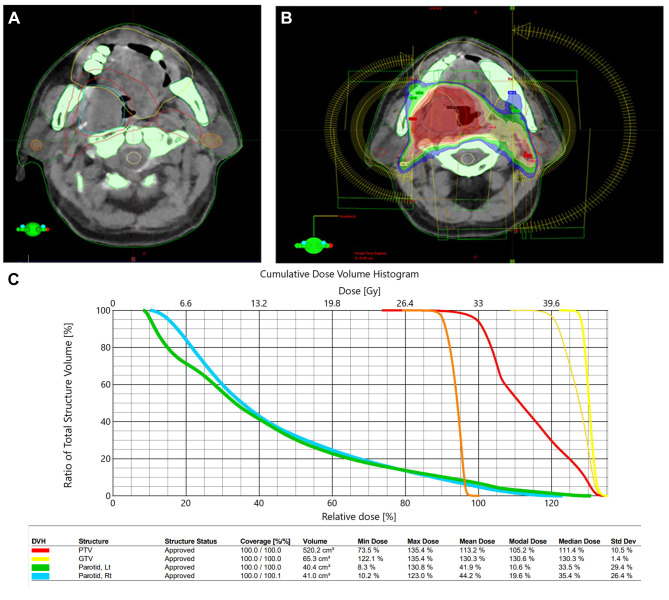Abstract
Background/Aim
Parotid oncocytomas typically present as benign, unilateral, slow-growing, painless, and solitary masses that are histologically firm and multilobulated. They are often misdiagnosed as pleomorphic adenomas, hemangiomas, or other forms of oncocytosis. However, in our case, the parotid oncocytomas initially mimicked bilateral parotid gland metastasis of advanced oropharyngeal cancer. Here, we present a case of oropharyngeal cancer with bilateral parotid oncocytomas treated with chemoradiotherapy (CCRT).
Case Report
We report the case of a 74-year-old man with a sore throat, neck pain, right earache, oropharyngeal cancer, and bilateral parotid gland oncocytoma. Head and neck computed tomography and magnetic resonance imaging (MRI) showed soft-tissue swelling in the right tonsillar fossa and several enlarged level II neck lymph nodes. MRI revealed enhancing masses in both parotid glands, initially suspected to be metastatic lymph nodes. A biopsy of the right palatine tonsil confirmed squamous cell carcinoma with human papilloma virus-16 positivity. A positron emission tomography scan was performed, and biopsy-proven malignant lesions were observed in the right tonsillar region with metastatic lymph nodes in the right and left neck. Focal hypermetabolism was observed in the parotid glands, suspected to be pathological lesions such as metastatic intra-parotid lymph node or Warthin’s tumor. An ultrasonography-guided biopsy of the left parotid gland confirmed an oncocytoma. Based on these results, the patient was scheduled for CCRT. After pathological confirmation of parotid oncocytoma, CCRT was administered, excluding the parotid glands within the radiotherapy field.
Conclusion
This is a case of bilateral parotid gland oncocytoma mimicking oropharyngeal cancer.
Keywords: Parotid gland, oncocytoma, oropharyngeal cancer, radiotherapy
Parotid oncocytomas are rare (<1% of all salivary gland tumors) (1). These benign epithelial tumors originate from oncocytes and commonly occur in major salivary glands, with the parotid gland being the most frequently affected, comprising 80% of all salivary gland oncocytomas (1). Oncocytomas typically present as benign, unilateral, slow-growing, painless, and solitary masses that are histologically firm and multilobulated (2,3). They are often misdiagnosed as pleomorphic adenomas, hemangiomas, or other forms of oncocytosis due to their similar appearance (1). Morphological similarities between benign and malignant tumors complicate diagnosis. Metastasis to the parotid gland can occur from head and neck cancer (4). However, in our case, the parotid oncocytomas initially mimicked bilateral parotid gland metastasis of advanced oropharyngeal cancer. We report a case of oropharyngeal cancer with bilateral parotid oncocytomas treated with chemoradiotherapy (CCRT) in a 74-year-old man.
Case Report
We report the case of a 74-year-old man with a sore throat, neck pain, right earache, oropharyngeal cancer, and bilateral parotid gland oncocytoma. Head and neck computed tomography (CT) showed soft tissue swelling in the right tonsillar fossa and several enlarged level II neck lymph nodes on the right side. A biopsy of the right palatine tonsil confirmed squamous cell carcinoma with human papilloma virus-16 positivity. Magnetic resonance imaging (MRI) revealed an approximately 5cm irregular, heterogeneous enhancing mass in the right palatine tonsil with enlarged lymph nodes at right levels II and III and left level II. Enhanced masses were also observed in both parotid glands, suspected to be metastatic lymph nodes (Figure 1). Positron emission tomography (PET) scan showed biopsy-proven malignant lesions in the right tonsillar region and metastatic lymph nodes on both sides of the neck. Focal hypermetabolism was observed in the parotid glands, suspected to be a pathological lesion such as a metastatic intra-parotid lymph node or Warthin’s tumor (Figure 2). An ultrasonography-guided biopsy of the left parotid gland confirmed an oncocytoma (Figure 3). Based on these diagnostic results, the patient was scheduled for CCRT. For radiotherapy (RT), the tumor contour, excluding the parotid lesions, was delineated on planning CT. He received CCRT at a planned target volume dose of 54.45 Gy for 6-7 weeks (PTV 1.65 Gy, CTV 2 Gy, GTV 2.12 Gy daily fractions, totaling 33 fractions) (Figure 4). During the follow-up period after completing RT, recurrence of the primary lesion was detected, leading to surgery for the recurrent lesions, followed by adjuvant chemotherapy.
Figure 1.
MRI findings. A) Approximately 5×4.3×4.1cm sized irregular, heterogeneous enhancing mass at the right palatine tonsil and enlarged lymph nodes at the right level II, III, and left level II. (arrows). B) Approximately 1.7 cm in size, enhancing the mass at the left parotid gland (double arrows) and small-enhancing lymph nodes at the right parotid gland (arrows).
Figure 2.
PET findings. A) Hypermetabolic lesion in the right posterior oral cavity (tonsillar region) and focal hypermetabolism in the right parotid gland. B) Hypermetabolic lesions in the right neck level II/III and left neck II.
Figure 3.
Microscopic finding. A) The tumor consists of sheets and nests of monotonous epithelial cells (H&E×100). B) The tumor cells have abundant eosinophilic granular cytoplasm and bland nuclei without atypia (H&E×400).
Figure 4.
Radiotherapy (RT). A) Contouring for tumor (green color), target (red color), and parotid gland (normal tissue) with oncocytoma (Magenta color). B) Volumetric modulated RT planning (90% isodose line, axial view) showed the sparing of both parotid glands. C) The dose volume histogram showed the relationship between the relative dose and ratio of total structure volume; and the dose statistics tabulated and met the limitation of radiotherapy tolerance dose of the parotid glands.
Discussion
Here, we report a case of oropharyngeal cancer with bilateral parotid gland oncocytoma treated with CCRT. At the initial visit, the diagnosis was suspected to be parotid gland metastasis of oropharyngeal cancer based on MRI and PET imaging. However, bilateral parotid gland metastases in oropharyngeal cancer are common (5). A pathological biopsy of the parotid mass was performed to confirm the diagnosis, revealing an oncocytoma of the parotid gland. Without this biopsy, the RT field might have included both parotid glands, potentially resulting in permanent xerostomia. After treatment, no moderate-to-severe toxicities related to CCRT were observed, although the follow-up period was short. To our knowledge, this is the first reported case of oropharyngeal cancer with bilateral parotid gland oncocytoma.
Epidemiologically, oncocytomas predominantly occur in older adults, usually in the seventh or eighth decades of life (3). This finding is consistent with our case. Notably, in our case, oncocytomas were found in both parotid glands, although bilateral parotid oncocytomas have rarely been reported (6).
Diagnostically, oncocytomas have been reported in pathology literature, with few reports on MRI imaging features showing oncocytomas as hypointense, well-demarcated lesions on T1-weighted sequences (7). In our case, T1-weighted MRI showed hypointense, well-demarcated, enhancing lesions in the bilateral parotid glands.
PET is a useful diagnostic tool for evaluating parotid gland masses (2). However, the initial PET findings in our case revealed focal uptake within the parotid gland, suspected to be a pathologic lesion, such as the metastatic intraparotid lymph node of an advanced oropharyngeal cancer or Warthin tumor.
However, the final diagnosis cannot be determined by diagnostic imaging studies such as MRI and PET. If these findings were detected in other areas of the head and neck, a pathological diagnostic workup would not be considered. However, parotid masses are commonly diagnosed as benign rather than malignant tumors. In cases of head and neck cancer with bilateral parotid gland metastases, ruling out parotid gland disease is crucial. Therefore, pathological examination should be performed to avoid unnecessary overtreatment. Pathologically, oncocytomas are well-circumscribed tumors composed of large polyhedral cells with abundant eosinophilic granular cytoplasm arranged in alveolar or glandular patterns. The nuclei of the cells are centrally placed, large, and hyperchromatic (3). Accordingly, findings compatible with oncocytomas were also revealed in our case.
Complete surgical excision with radical or superficial parotidectomy is recommended as the treatment of choice, with the extent of excision determined by preoperative clinical and radiological findings (3). Initially, no symptoms related to parotid gland oncocytomas were observed. Therefore, a treatment plan for parotid gland oncocytomas was not established, even after treatment for oropharyngeal cancer. Although CCRT affected the degree of xerostomia development in our case, full development of xerostomia cannot be avoided after CCRT if both parotid glands are included within the initial RT field. In our case, for RT, target volume delineation excluding both parotid lesions avoided xerostomia.
During regular surveillance, we will evaluate the necessity of treatment for the parotid oncocytoma. If the patient complains of related symptoms or there is evidence of progression on imaging studies during the follow-up period, treatment, such as parotidectomy, will be performed. On the follow-up CT and MRI, there was no significant change in the size and shape of the oncocytoma. As a result, sparing both parotid glands after CCRT for oropharyngeal cancer can be achieved, and morbidities due to radiation-induced xerostomia can be avoided. However, further follow-up is needed to confirm the preservation of saliva production.
Conclusion
Here, we report a case of oropharyngeal cancer with oncocytoma of the bilateral parotid glands, which initially mimicked oropharyngeal cancer with metastasis to the parotid glands. After pathological confirmation of parotid oncocytoma, the patient was treated with CCRT, excluding the parotid glands within the RT field. In suspected cases of parotid metastasis from primary head and neck cancer, such as advanced oropharyngeal cancer, further pathologic diagnostic workup for suspected parotid lesions should be performed to rule out other possible parotid tumors.
Conflicts of Interest
The Authors have no conflicts of interest to declare in relation to this report.
Authors’ Contributions
SH Lee cared for the patient and wrote the manuscript. SH Lee and WR Park contributed to the surgical and patient management of this case. SH Lee, WR Park, and DH Jung have read and approved the final version of the manuscript. All Authors approved the final version of the manuscript.
References
- 1.Sharma V, Kumar S, Sethi A. Oncocytoma parotid gland. Ann Maxillofac Surg. 2018;8(2):330–332. doi: 10.4103/ams.ams_154_17. [DOI] [PMC free article] [PubMed] [Google Scholar]
- 2.Sepúlveda I, Platín E, Spencer ML, Mucientes P, Frelinghuysen M, Ortega P, Ulloa D. Oncocytoma of the parotid gland: a case report and review of the literature. Case Rep Oncol. 2014;7(1):109–116. doi: 10.1159/000359998. [DOI] [PMC free article] [PubMed] [Google Scholar]
- 3.Singh J, Chandra A, Srilatha T, Jain T, Raja D, Agrawal R. Oncocytoma of the parotid gland: A rare benign tumour. J Oral Maxillofac Pathol. 2023;27(Suppl 1):S41–S44. doi: 10.4103/jomfp.jomfp_437_21. [DOI] [PMC free article] [PubMed] [Google Scholar]
- 4.He A, Lei H, Li H, Li X, Yang Y, Wang Y, Ong H, Zhao X, Ruan M, Han N. Metastatic parotid gland malignancy: A preliminary study in an eastern Chinese population. J Stomatol Oral Maxillofac Surg. 2023;124(2):101309. doi: 10.1016/j.jormas.2022.10.008. [DOI] [PubMed] [Google Scholar]
- 5.Olsen SM, Moore EJ, Koch CA, Kasperbauer JL, Olsen KD. Oral cavity and oropharynx squamous cell carcinoma with metastasis to the parotid lymph nodes. Oral Oncol. 2011;47(2):142–144. doi: 10.1016/j.oraloncology.2010.11.010. [DOI] [PubMed] [Google Scholar]
- 6.Palmer TJ, Gleeson MJ, Eveson JW, Cawson RA. Oncocytic adenomas and oncocytic hyperplasia of salivary glands: a clinicopathological study of 26 cases. Histopathology. 1990;16(5):487–493. doi: 10.1111/j.1365-2559.1990.tb01549.x. [DOI] [PubMed] [Google Scholar]
- 7.Patel ND, van Zante A, Eisele DW, Harnsberger HR, Glastonbury CM. Oncocytoma: the vanishing parotid mass. AJNR Am J Neuroradiol. 2011;32(9):1703–1706. doi: 10.3174/ajnr.A2569. [DOI] [PMC free article] [PubMed] [Google Scholar]






